METODE ONE TIME PASSWORD MODIFIED SEBAGAI SISTEM KEAMANAN MONITORING IOT
Abstract
Monitoring is an activity carried out to find out the process of running a program or system that has been designed, whether it runs well as expected or not, find out the obstacles that occur and how to overcome these obstacles. The cryptographic scheme to secure communication protocols is one of the most effective defenses against a variety of attacks, including eavesdropping and simple routing attacks, at the communication layer. One of the techniques studied in cryptography is encryption-description. This study aims to apply a one time password (OTP) modified algorithm into an IoT based temperature and humidity monitoring system using a Raspberry PI microcontroller device and a DHT 11 sensor. . The encryption process begins with hashing using the SHA method on the plaintext, followed by producing a private key and public key for RSA Signature encryption, the hashing results will be encrypted using the RSA Signature algorithm, the RSA Signature encryption results will be combined with the RSA Signature public key and plaintext, followed by producing an OTP that will be used as an AES key. Next the AES encryption process is executed, the OTP key will be encrypted RSA, the results of the RSA ciphertext and the AES ciphertext are combined and encoded with the Base64 method. The implementation of this security system gets the test results of the average duration for data encryption process is 435,163ms, and the data transmission with encryption process is 123,705ms
References
[2] M. A. Iqbal, O. G.Olaleye, and M. A. Bayoumi, “A Review on Internet of Things (Iot): Security and Privacy Requirements and the Solution Approaches,” Univ. Louisiana Lafayette, vol. 16, no. 7, pp. 331–333, 2016, doi: 10.1111/j.1399-6576.1984.tb02071.x.
[3] W. Najib, S. Sulistyo, and Widyawan, “Tinjauan Ancaman dan Solusi Keamanan pada Teknologi Internet of Things (Review on Security Threat and Solution of Internet of Things Technology),” J. Nas. Tek. Elektro dan Teknol. Inf. |, vol. 9, no. 4, pp. 375–384, 2020.
[4] A. Sumarudin, W. P. Putra, E. Ismantohadi, S. Supardi, and M. Qomarrudin, “Sistem Monitoring Tanaman Hortikultura Pertanian Di Kabupaten Indramayu Berbasis Internet of Things,” J. Teknol. dan Inf., vol. 9, no. 1, pp. 45–54, 2019, doi: 10.34010/jati.v9i1.1447.
[5] N. Indahwati and A. Prihanto, “Penerapan Algoritma Kriptografi Asimetris Elgamal dengan Modifikasi Pembangkit Kunci terhadap Enkripsi dan Dekripsi Gambar Warna,” J. Informatics Comput. Sci., vol. 1, no. 02, pp. 97– 103, 2020, doi: 10.26740/jinacs.v1n02.p97-103.
[6] R. Pasmah, A. J. Lubis, and A. Usman, “Prototipe Sistem Keamanan Ruangan Menggunakan Finger Print dan Keypad Matrix dengan One Time Pad,” Explorer (Hayward)., vol. 1, no. 2, pp. 53–62, 2021, doi: 10.47065/explorer.v1i2.89.
[7] Wilianto and A. Kurniawan, “Sejarah , Cara Kerja Dan Manfaat Internet of Things,” Matrix, vol. 8, no. 2, pp. 36–41, 2018.
[8] B. Rahardjo, “Keamanan Informasi & Jaringan,” p. 47, 2017, [Online]. Available: http://budi.rahardjo.id/files/keamanan.pdf.
[9] E. S. Han and A. goleman, daniel; boyatzis, Richard; Mckee, “Peranan Kriptografi Sebagai Keamanan Sistem Informasi Pada Usaha Kecil Dan Menengah,” J. Chem. Inf. Model., vol. 53, no. 9, p. 2, 2019.
[10] Arafat, “Sistem Pengamanan Pintu Rumah Berbasis Internet of Things (IoT) dengan ESP8266,” J. Ilm., vol. 7, no. 4, pp. 262–268, 2016.
[11] N. Azis, “Perancangan Aplikasi Enkripsi Dekripsi Menggunakan Metode Caesar Cipher dan Operasi XOR,” Ikraith-Informatika, vol. 2, no. 1, pp. 72– 80, 2018.




